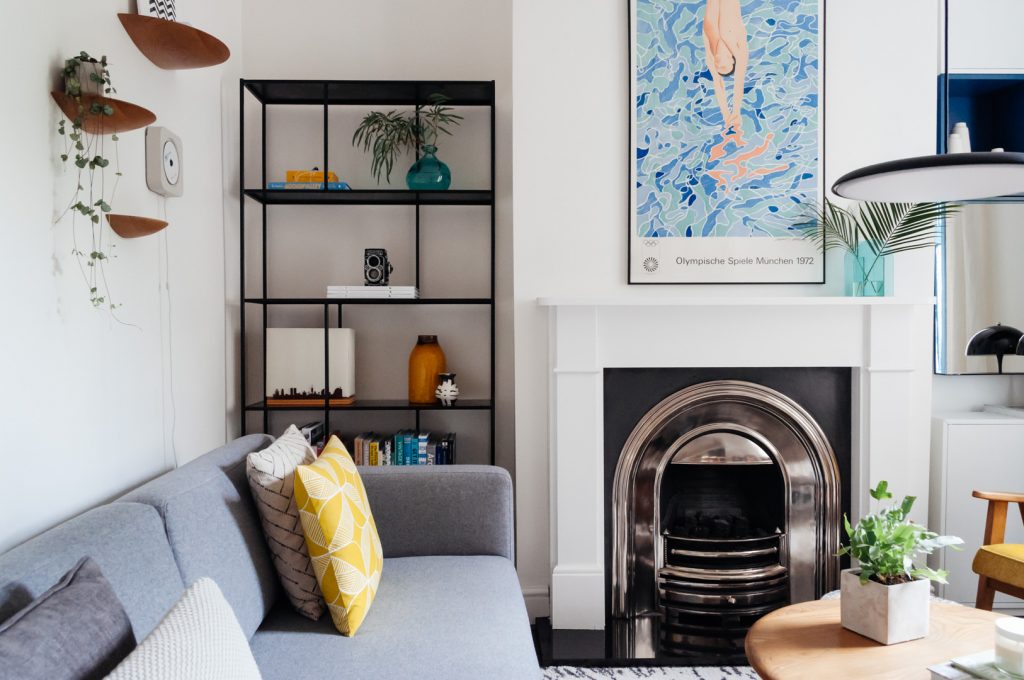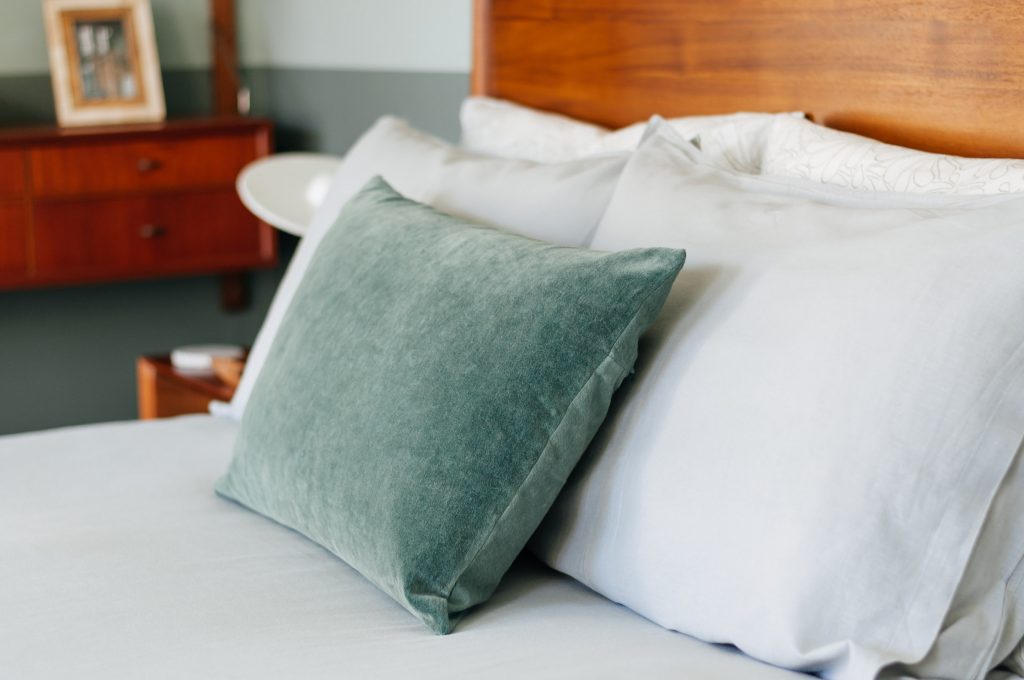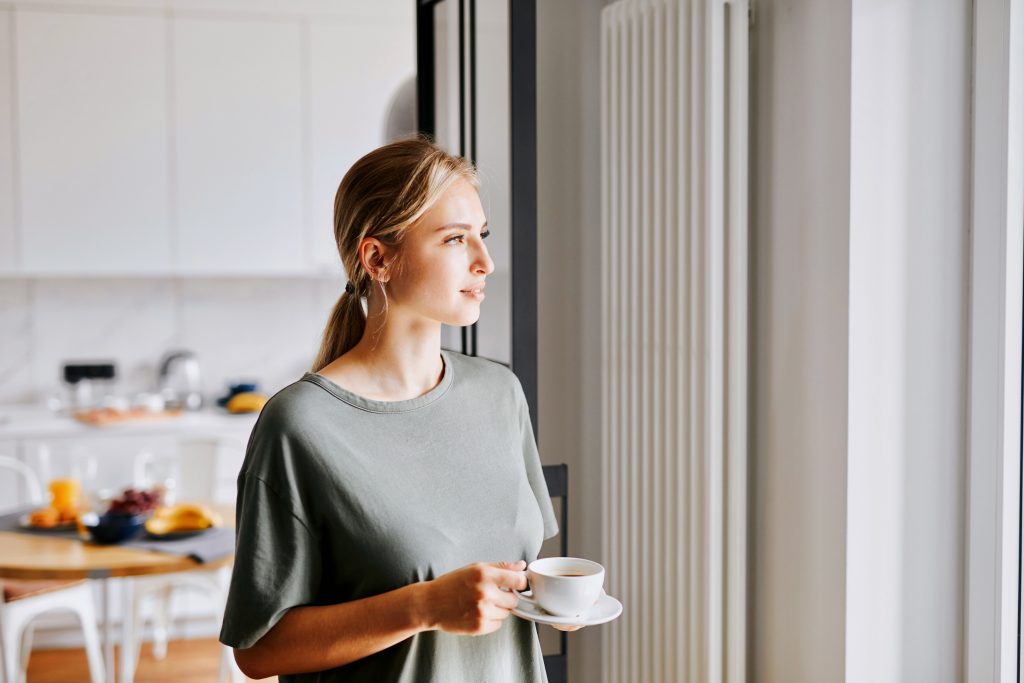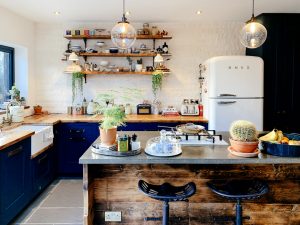Is your home the calm space you deserve? Or is it somewhere in between organised chaos and Jumanji aftermath?
When you walk into your home after a long day, it should be a place that calms you down and makes you feel at peace. It should be the one place where you can forget about all your worries, recharge your batteries and be your true self.
In this room-by-room guide, I will show you how to create a calm home. Starting with the living room and bedroom, then working through the kitchen and bathroom.
Let’s create peaceful spaces and turn your home into your very own wellness sanctuary.
Why you need to create a calm and relaxing home
Looking back, I realise I had the privilege of enjoying my own space growing up. My little blue room, with my glow-in-the-dark space stickers and dinosaur skeletons (which also happened to glow in the dark). But everything changed when I turned 18 and went to university. My first year was spent sharing a bedroom with a total stranger.
How can you enjoy privacy and relaxation when you’re sharing a room? Where do you go when you need to disconnect for a while?
Adapt. Create new ways to find calm. Focus on what you can do.
I never had to share a bedroom in the same way again — even though a cat or two would be nice, to be honest. Years later, when studying interior design and the science of wellbeing, I realised the coping strategies I used back then. And also the things I could have done better.
You need a calm home to survive in this always-connected world, where you are bombarded by constant information — positive and negative.
It’s not about denying reality and choosing isolation. It’s about creating a nurturing environment that allows you to thrive, be present, and facilitates physical and mental health.
A calm home is essential for your wellbeing.

The three principles to create a calm home
But what is a calming home, anyway? For me, it’s simple.
A calm home is a space that meets all your needs and provides you with plenty of opportunities to be more mindful every day. A space that perfectly balances stimulation and relaxation.
Ultimately, a peaceful home has the power to comfort you and promote your wellbeing.
To understand the science of a calm home, we have to look into the three principles that influence it. I will provide practical examples as I apply them to every room in the house later on.
1. Silence
Your brain craves silence. It doesn’t matter how soothing ambient music is, silence is proven to have a beneficial effect on your body and mind1. Rather than living life as if you’re in the film A Quiet Place, it’s about having the opportunity to choose silence when you want it.
2. Visual Balance
Visual discomfort can occur because of inefficient lighting and… decor!2 Yes, bad decor hurts. Luckily, it’s easy to solve by following a few simple guidelines. Visual balance relates to how “loud” or plain a room is. Think bold patterns, bright colours, the presence or absence of white space, etc.
3. Comfort & Privacy
It doesn’t matter how pretty that armchair you saw on Instagram is. If it’s uncomfortable, then it has failed from the design point of view. You deserve a warm, dry, comfortable home. A home where you can be yourself, with the right level of privacy you need.

A room-by-room guide to designing peaceful spaces
This step-by-step guide will show you how to create a calm home. Let’s start with my Golden Tips, and the areas where you spend more time: the living room and bedroom. Then, I’ll share more advice on other vital spaces, such as the kitchen and bathroom.
The Two Golden Tips
These work in every room in your home. Use them freely!
- Adding greenery and plants has been shown to have a positive impact on your health. You can read my in-depth blog post on indoor plants and wellbeing.
- Your brain favours natural materials. From a simple wooden tray to linen curtains. The key is to see, and feel, the natural grain or texture of the material.
The Living Room
The living room is the social hub of your home. It’s where you see friends and family, and it’s the room where you spend a significant amount of time. You want your living room to be a welcoming space for everyone, but specifically for you.
Living rooms are designed for activity: from watching TV to entertaining guests. However, you need to enjoy time without noise distractions. For example, don’t leave the TV on for no reason; and turn off any unused device that makes background noise (like a humming computer).
This makes other activities, such as reading, petting a cat, or listening to a loved one, more pleasurable.
Another important element that makes a living room calming is the colour scheme. Your colour scheme should match the atmosphere you’re trying to create. The choice is yours to make.
Do you prefer dark and cosy? Or bright and spacious? If you choose the latter, this blog post is a compulsory read: how to make a small room look bigger.
Invest in good quality furniture to maximise comfort above anything else. If you have a tight budget, focus only on the single piece you’ll be using (a small sofa, an armchair, etc.)

The Bedroom
The bedroom has the potential to be one of the most relaxing spaces in your home. It’s where you get to rest and recharge after a long day. When creating a space that’s calming and peaceful, start with the colours.
You want colours that don’t stimulate the senses too much. Bold wallpapers and loud colours can work in a guest room, but can be more challenging when you have to live with them every day! I recommend experimenting with samples and avoiding making rushed decisions.
Remember that just because you like a colour, it doesn’t mean it’s relaxing. And a colour you find calming may cause the opposite effect on someone else. This is something to think about if you live with other people. Working with an Interior Consultant can make the colour selection process much easier.
Are you interested in the power of colour psychology? I have the perfect blog post for you.
With lighting, the key is to master the ambient light: low wattage, warm white and indirect. The main ceiling light should be soft and diffuse, if ever used at all.
And if you like to read in bed, make sure you have a task light available from behind, even if you use eReaders/tablets. Your eyes will thank you.
Don’t forget to remove clutter or anything else that might disrupt your peace of mind. You want this space to be as tranquil as possible so it’s an oasis from the outside world.
Further reading: how to design a relaxing bedroom and get better sleep.

The Kitchen
The kitchen is a space where you can easily get stressed — surely I can’t be the only one. A lot can happen at the same time, especially if you live with others or have pets. But there are ways to make it more peaceful, to help you balance the pressures of everyday life.
Arrange your kitchen in such a way that promotes movement.
If you are designing a kitchen, consider placing an island in the middle, if space allows. This will help promote movement because you’ll be able to go back and forth between different areas of the room with ease. Like water flowing through a well-defined river. It will feel less cramped and more enjoyable.
Even if your kitchen is already in place, there are things you can do too. Keep the countertops and sink clean and clutter-free. Every utensil should have its regular place in the kitchen — hidden, if you have enough storage. And yes, it’s true everyone has a messy drawer in the kitchen, but try to keep it under control. Those half-burned birthday candles can go.
Think: does this belong in the kitchen?
You can also add seasonal flowers into your kitchen for some colour and life in an otherwise sterile space. With these changes in place, your kitchen will become a place that calms you down instead of stressing you out — “Where’s the potato masher!?”

The Bathroom
The bathroom can be your very own luxury spa. It’s where you spend a lot of time taking care of yourself, so it should be calming and relaxing. To create this space, start by choosing the right lighting.
White lights are ideal because they can give off an ambient glow that mimics natural daylight. They’re also better at showing the true colour of the skin, something essential in skincare routines.
This is the basic lighting set-up you can try: two wall lights placed at both sides of the mirror (eye level or slightly higher).
You can also add to the spa-like atmosphere by using scented candles and sprays when having a bath or as part of your winding down night routine.
Certain scents like camomile or lavender can help you relax (even though there is no direct link with sleep). Look for products that contain natural essential oils, rather than man-made fragrances. Make sure there is good ventilation, like a quiet extractor fan.
And don’t overdo it — or your bathroom will smell like Sephora during a sale.
There are plenty of options to make your bathroom extra private. From simple frost-effect window film to moisture-resistant shutters. Also, a door lock that actually works is helpful if you share the bathroom with others! It’s worth looking into this, as you can feel uneasy in this space otherwise.
Ready to create a calm home?
Creating a peaceful home is easier than you may think. The key is to follow the three principles: silence, visual balance and comfort/privacy. And make the most of the two Golden Tips — add plants and use natural materials.
With these solid foundations, you will create relaxing spaces that promote your wellbeing.
What else have you tried that worked? Let me know your soothing space tips in the comments below.
Images 1, 2, 3 and 6 are licensed by Adobe Stock.





